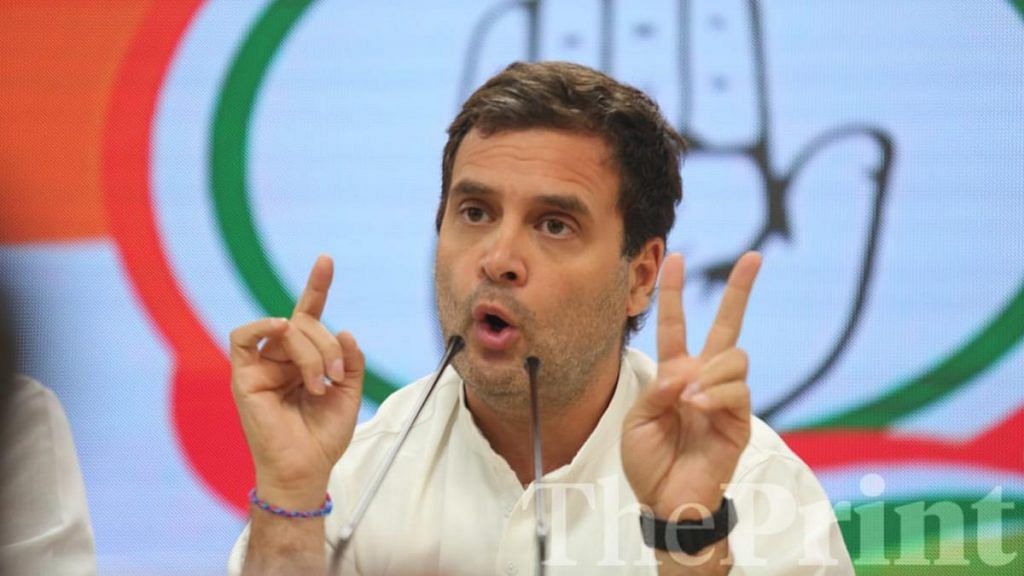Rahul Gandhi’s promise of a minimum basic income, the biggest income transfer programme to be announced, is fraught with challenges.
There is a fundamental problem in the proposition that only the bottom 20 per cent poorest households can be targeted. The average income of the bottom 40 per cent of the population is below Rs 1.44 lakh per year. A scheme in which half of them will be given income transfers assumes that people do not change behaviour in response to government policies.
The ‘Lucas critique’, a popular argument in economics in the context of macroeconomics, argues that it is naïve to assume that people do not respond to policy changes in a rational way. If we predict behaviour based on historical data, the predictions can often go wrong. The NYAY scheme is likely to suffer from a similar critique. We illustrate this below.
Household income distribution in 2017 (population weighted distribution based on the latest available CMIE survey Consumer Pyramids), shows the following:
(i) The average income of the bottom 20 per cent of the households is approximately Rs 77,000. This is the targeted group for the cash transfer. Households are to be given an additional Rs 72,000 so that their income becomes around Rs 1,44,000, to give them Rs 12,000 per month, the minimum basic income.
(ii) The average income of the next 30 per cent of households, those above the 20 per cent poor households being targeted and up to half the households in India, is Rs 1.25 lakh.
After the income transfer to the poorest 20 per cent, those with income levels up to Rs 1.25 lakh will be poorer than those receiving income transfers. These households will be better off by not earning the Rs 1.25 lakh per year that they are currently earning, and dropping below the poverty line to avail of the income transfer. That way, they will be able to get incomes of Rs 1.44 lakh per year.
In fact, households do not need to even earn less. They simply do not have to report how much they are earning. After all, how will income be measured? Given informal, agricultural income and daily wage employment among the poor, it is not as if their income is credited to their bank accounts. Income earned from growing crops and livestock is particularly difficult to measure.
If income is based on surveys such as NSSO, which have been used to measure household incomes and consumption, the rational response to a cash transfer scheme for families below Rs 72,000 will be for all families near that level or somewhat above it to report that their incomes are lower than they actually are. In any case, lines between Rs 6,000 per month and Rs 8,000 per month, especially when incomes are uncertain and seasonal and constantly fluctuating, are too thin and too difficult to identify.
Even without the above scenario of a larger number of absolute poor, this scheme also raises questions about the fiscal cost and how the Congress plans to fund it. Rs 3.6 lakh crore or thereabouts is not a small sum.
Considering how difficult it is for governments to reduce expenditure such as those on salaries or interest payments, the question is what expenditure will be reduced? Will it be the various existing schemes? If so, which ones?
Will subsidies be cut? Or, will borrowing be increased and fiscal targets crossed?
Will tax rates be raised? If tax rates are increased, will it be the GST rate? Or will GST still be lowered, as the Congress has indicated earlier? Will direct tax rates be increased beyond the present rates? Personal income tax slabs at the highest levels are already effectively at 33 per cent. If 18 per cent goes on average as consumption taxes (i.e. GST), then salaried middle-class households in India in this tax bracket are already paying 50 per cent of their income as taxes. Will the tax burden on them be increased?
Budget 2019 barely managed to meet fiscal targets: Fiscal deficit numbers were kept in control by showing disinvestment targets met by sale of one PSU to another, bonds sold by PSUs and by postponing expenditures. Meeting deficit targets will be an equally tough challenge next year.
In an economy where the biggest problem is employment, poverty reduction by income transfers is a palliative, but not a solution. Transfer payments need to be accompanied by a reform programme for increasing investment, growth and jobs. While cash transfers are the least distortionary way of poverty alleviation, they are not a long-term sustainable solution for income growth.
The author is an economist and a professor at the National Institute of Public Finance and Policy. Views are personal.
Also read: Basic income for poor demands subsidy cuts, a step govts in India are unlikely to take
